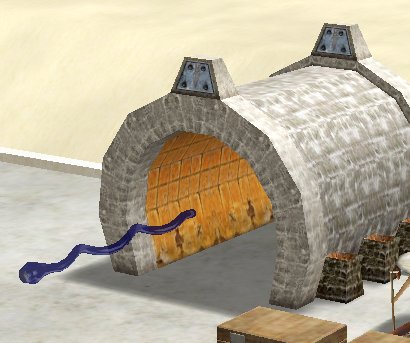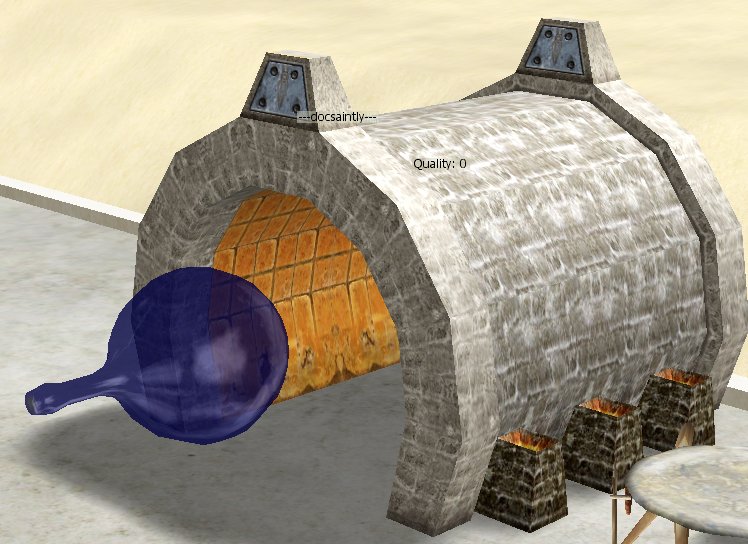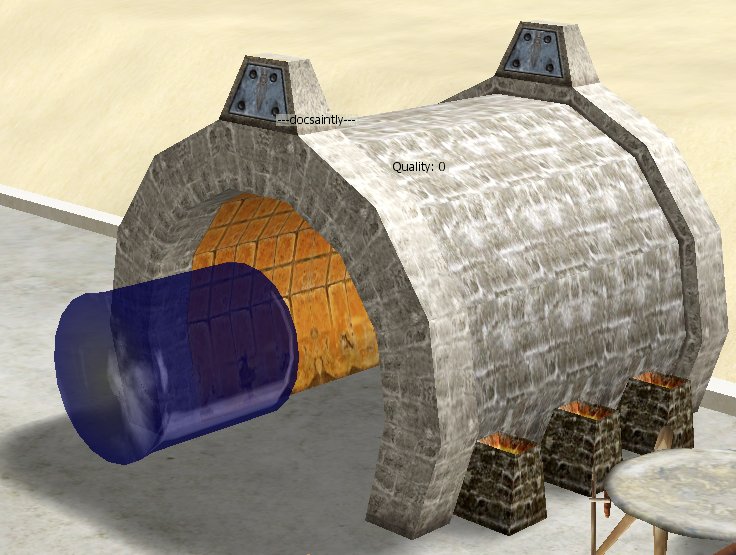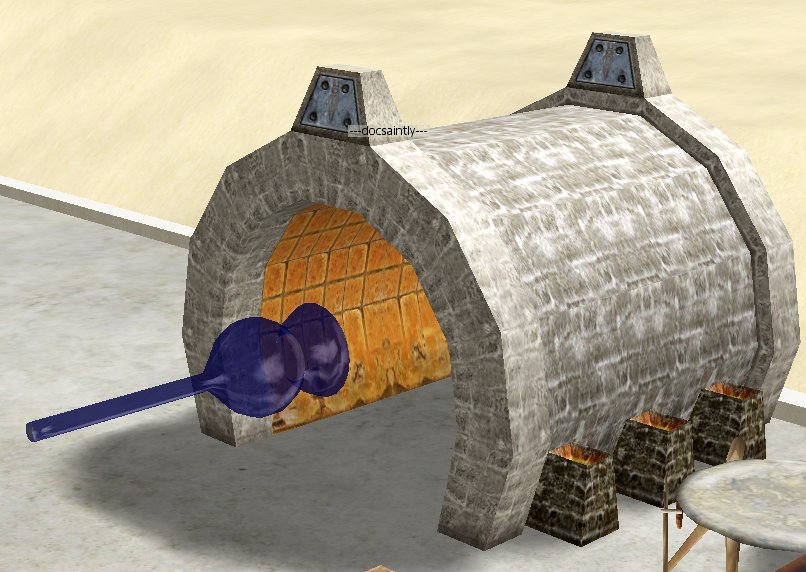The Wiki for Tale 4 is in read-only mode and is available for archival and reference purposes only. Please visit the current Tale 11 Wiki in the meantime.
If you have any issues with this Wiki, please post in #wiki-editing on Discord or contact Brad in-game.
Difference between revisions of "Glassblowing Guide"
| Line 91: | Line 91: | ||
**Rotate until droop of bulb is pointing up and stop rotating a couple clicks to let it droop back to normal while hitting 'q'. You can often improve the quality enough to save it this way. ~Ariella~ | **Rotate until droop of bulb is pointing up and stop rotating a couple clicks to let it droop back to normal while hitting 'q'. You can often improve the quality enough to save it this way. ~Ariella~ | ||
| − | ==== | + | ==== oicurtis ==== |
| − | *''' | + | *'''Standard''' |
*Rush the pipe in, pull it out seven times, rotate while it heats. Blow three to four times while rotating, unload when the quality rises above 3500. Four blows should ensure this, while five will risk a ruined project. | *Rush the pipe in, pull it out seven times, rotate while it heats. Blow three to four times while rotating, unload when the quality rises above 3500. Four blows should ensure this, while five will risk a ruined project. | ||
| + | |||
| + | === Quizzical=== | ||
| + | *While making a thermometer (or anything else in a glory hole, for that matter), you want to spin constantly to keep the glass rotationally symmetric, rather than letting it droop off in some direction. I prefer to stand just behind the Glory Hole, and zoom in close enough to get a good look at what I'm doing. Set the heater control to Pinpoint. Don't operate a glory hole near peak times, as it is very sensitive to lag. | ||
| + | |||
| + | *For purposes of making thermometers, let us define a "tick" as a unit of time equivalent to about 2/3 of a second real time. A "step" is a how far the pipe moves when you push or pull it once. | ||
*After starting a thermometer, start rotating, and then quickly push the thermometer all the way in. You don't want to heat any part of the pipe very much while pushing it in. You can tell that it's all the way in if you try to push it further in and it doesn't move. Once the pipe is all the way in, quickly pull it back out by 6 steps. If the pipe stays all the way in for several seconds, that's fine, but once you start pulling it back out, you need to get it out by 6 steps pretty fast. | *After starting a thermometer, start rotating, and then quickly push the thermometer all the way in. You don't want to heat any part of the pipe very much while pushing it in. You can tell that it's all the way in if you try to push it further in and it doesn't move. Once the pipe is all the way in, quickly pull it back out by 6 steps. If the pipe stays all the way in for several seconds, that's fine, but once you start pulling it back out, you need to get it out by 6 steps pretty fast. | ||
Revision as of 03:50, 30 September 2009
This guide came from the T3 Wiki. Please update!
WARNING: The Push and Pull hotkeys are reversed on the menu from the way they actually operate. A is push (into the GH), S is pull (out of the GH). Also, like all buildings with hotkeys, your mouse cursor must be touching the actual building in order for the hotkeys to register.
Basic Concepts
Glassblowing is a timed craft, giving you approximately one minute from the time you start a project to heat and work the glass. To become a decent glassblower, plan on spending a great deal of time and glass familiarizing yourself with the glory hole and its quirks. A gloryhole in a low-lag area and a fast, stable connection to the game are highly recommended, if not outright required. Additionally, it's vital to learn and use the hotkeys. Menu-based glassblowing projects will give extremely poor results in almost every situation.
Every 'tick' of the process, several things happen automatically.
- Any part of the project that is within the heating plane (varies based on heat settings) will heat up
- Any part of the project that is outside of the heating plane will cool down
- Any part of the project that is heated will sag towards the ground
Similarly, every 'tick' the user has a few options that affect the project
- Move the project further into or out of the glory hole
- Rotate the project, typically to counter the sagging effect
- Blow the glass, which widens the project based on its heat level. Unheated glass will be unaffected.
- Discard the project, destroying any materials in use
- Unload the project, receiving a finished item of whatever quality level you've currently acheived
There are a couple things a user can do that won't directly affect the project
- Check the goal display to get a reference point for what needs to be done
- Check the quality level for feedback on how well the project is going
Notes: quality varies wildly based on the rotation orientation and changes every tick, fast fingers help. You want to spin constantly to keep the glass rotationally symmetric, rather than letting it droop off in some direction. Don't operate a glory hole near peak times, as it is very sensitive to lag. Keep the mouse pointer on the project itself rather than somewhere on the building to see the quality.
Hotkeys
- G - Goal Display
- A - Moves the project into the glory hole
- S - Moves the project out of the glory hole
- Q - Check the current quality
- N - Rotate counterclockwise
- M - Rotate clockwise
- U - Unload (complete) the project
- D - Discard the project, destroying the materials
- B - Blow into the tube
Wine Glass
Requires: 1 Fine Glass Rod
Methods
Hookah Bowl
Requires: 1 Fine Glass Rod
Methods
- Pin Point Heat
- Constantly spin to keep entire piece centered (there is a correct rhythm to spin it's not just spinning as fast as you can)
- Start the bowl shape at the bottom
- Move the glass in 2 times
- Move the glass in 3 times pausing between each
- blow 4 times
- Move the glass all the way inside the glory hole
- Make the mouth of the bowl
- Move the glass out 5 times
- blow 2 times
- Move the glass out 2 and then in 2 (turning the section just under the mouth brown/orange not yellow)
- blow 4 to 6 times
- Make the ridged middle body of the bowl
- Move the glass out 2 times
- Move the glass out 3 times (very quickly) (pause 'till this section is orange)
- Move the glass out 1 time (pause 'till orange)
- Move the glass out 3 times slowly pausing such that each segment just barely turns yellow (you want these 3 segments to heat up at the same time, so as you get better you can go back and forth over this area)
- Repeat over the next 3 segments
- Blow 2-3 times
Thermometers
Requires: 1 Glass Pipe, 1 Quicksilver
Methods
Ariella
- Pinpoint
- aaaaaaaaaa sssssss mmmmmmmmm bbbb mmmmmmm q mmmm u That's about it.
- 'a' held down to push it in clear to the back.
- Hit 's' EXACTLY 7 times to pull it back out.
- Rotate hitting 'm' til you see the frontish part turn a bit yellow.
- Hit 'b' EXACTLY 4 times to blow the bulb.
- Rotate with 'm' again until your pinky can hit 'q' to check the quality.
- Keep checking until it's over 3500 and hit 'u' quick as you can after you see that.
- TO REPAIR and bring less than 3500 quality up
- Rotate until droop of bulb is pointing up and stop rotating a couple clicks to let it droop back to normal while hitting 'q'. You can often improve the quality enough to save it this way. ~Ariella~
oicurtis
- Standard
- Rush the pipe in, pull it out seven times, rotate while it heats. Blow three to four times while rotating, unload when the quality rises above 3500. Four blows should ensure this, while five will risk a ruined project.
Quizzical
- While making a thermometer (or anything else in a glory hole, for that matter), you want to spin constantly to keep the glass rotationally symmetric, rather than letting it droop off in some direction. I prefer to stand just behind the Glory Hole, and zoom in close enough to get a good look at what I'm doing. Set the heater control to Pinpoint. Don't operate a glory hole near peak times, as it is very sensitive to lag.
- For purposes of making thermometers, let us define a "tick" as a unit of time equivalent to about 2/3 of a second real time. A "step" is a how far the pipe moves when you push or pull it once.
- After starting a thermometer, start rotating, and then quickly push the thermometer all the way in. You don't want to heat any part of the pipe very much while pushing it in. You can tell that it's all the way in if you try to push it further in and it doesn't move. Once the pipe is all the way in, quickly pull it back out by 6 steps. If the pipe stays all the way in for several seconds, that's fine, but once you start pulling it back out, you need to get it out by 6 steps pretty fast.
- Pause with the pipe 6 steps out, then pull it out one step per tick until it is 9 steps out. Pause there, and then push it back in at one step per tick until it is again only 6 steps out. Pause there as well, and then pull it back at one step per tick until it is 8 steps out. Once it gets to there, blow four times. Just to recap, at consecutive ticks, the number of steps out that you want the thermometer to be is 0, 6, 6, 7, 8, 9, 9, 8, 7, 6, 6, 7, 8 (blow 4x).
- If the thermometer has visibly in one direction, rotate it so that the bulb is as high as possible, and let it fall back toward the center for a couple seconds before taking it. You don't have to pull it out of the heat to do this.
- I broke the first thermometer I attempted, but the other 30-40 I've done have all worked. This method typically gives one of quality around 7k, and I've gotten over 8k several times. You only need 3500, of course, but it's better to try for 8k and end up with 5k than to try for 4k, mess up, and get a 2k that doesn't work. -Quizzical
Matk
- Front Heavy Heat
- Ram the thermo into the hole as fast as you can (hammering down the "a" key). Once it's all the way in, withdraw the pipe 7 steps "sssssss". At this point rotate half a turn - I wait until the pipe sags and then hit "n" 7 times fast to straighten the pipe out. Wait several ticks, the section of the pipe just shy of the end will get yellow, I usually rotate a half turn 2 more times while waiting to keep the pipe reaonably straight (7x "n"). Blow 4 times "bbbb". Rotate a half turn if necessary to center the bulb. Hit "q" to verify quality then unload. If quality isn't high enough, the worst you will have to do is rotate the pipe and let the bulb sag into place. 95 thermos and counting. - Matk
Distillation Coil
- Requires 1 Glass Pipe
- Use Pinpoint heat. Shove the pipe all the way into the glory hole, and then move it back out 6 steps. Keep rotating the glass to keep it even while the end heats up.
- Blow twice to make the bulb.
- Move the distillation coil out slowly one step at a time, allowing it to sag, then rotating it, then moving it out and repeating the process on the way out. If you have time, start sliding it back in again and adjust the sags to match the guide.
- With this one, always let the product finish changing and then test quality at each rotation of the piece before pulling it out. Orientation makes all the difference!
Barometric Sphere
Requires 1 glass rod to make. You must be signed up for Test of Life to get the option.
- Push the rod in about 4 clicks to heat the spot where the middle of the first bulb will be. Leave it for a few seconds until the middle of the bulb location is yellow, then quickly push the rod in to heat the centre of the second bulb. As soon as it's yellow, blow 5-10 times (not counted yet) to get two rough bulbs. It seems to help to leave the first bulb to heat slightly longer than the second to counter the cool down time while you're heating the second. I got spheres of 5-6k with this method.
You need 3 Barometric Spheres to make a Barometer. The ideal case is for the 3 spheres to be perfectly matched in quality (otherwise you lose quality on the barometer - see barometer page for the reason) and the easiest way to achieve that is to make lots of spheres, then pick the closest matched ones.
Chemistry
Test Tube
Requires: 1 glass rod
- Similar to a beaker - heat evenly, but ideally let the tip (the end nearest the glory hole) be the coolest part and heat the lip (the far end) last. Rotate constantly, trying to keep the heating even so there are as few sags as possible
blow only a couple of times (maybe 3), then check to see how close you are. Don't focus on the size of the lip - get the majority of the body correct first.
Florence Flask
Requires: 1 glass pipe
- Set heat to gradual, constantly rotating, move the piece in eleven steps. Once the heat radiates out close to the "front" of the piece, blow 12-14 times and check the quality. I average 6-7k at this point and simply unload.
Beaker
Requires: 1 glass pipe
- Beakers are short, so use whichever heating method you prefer. I get good results (7kish) with front heavy.
Rotating the piece to keep it as even and level as possible, heat the entire project. You'll need to move it back and forth through the heating plane repeatedly. Keeping the entire project as hot as possible, begin blowing. Go ahead and blow 9-10 times, you need to make the beaker wide. Check the quality at this point and blow as many more times as needed to raise the quality to appropriate levels. Rotate the project while checking the quality to find the "best" position, then unload. I ignore the "lip" as the time and effort required to try and nail it gives minimal payback.
Thistle Tube
Requires: 1 glass pipe
- Set heat to pinpoint for this one. Rotating constantly, move the project in once and allow the tip to heat up, then blow once. Move the project in one more time, allow it to heat again and blow twice. Move the project in so that the base can cool down to a deep red and heat up a few sections beyond that. When they're heated to yellow, blow a few times. Never stop spinning the project, and check the project. Forming just the two chambers as described, mid to high-end 7k quality is acheived in 10-20 seconds



